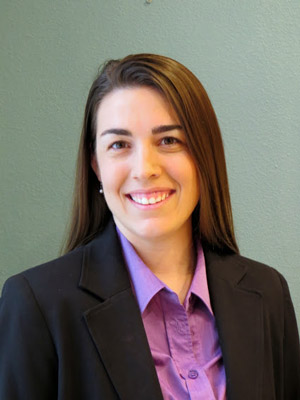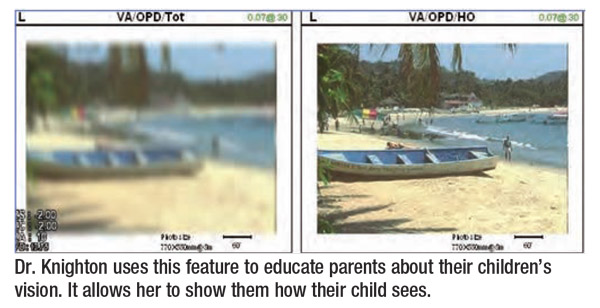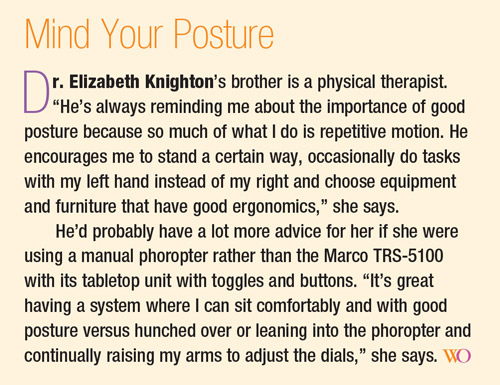

Explaining a child’s visual acuity to emmetropic parents is time-consuming and challenging. Or, at least, it used to be. Now Elizabeth Knighton, OD, FAAO, turns to her Marco technology to show parents an image of a boat on a beach that she can adjust to reflect how the child sees the same scene without correction. “It’s a real eye-opener, and it saves so much time because I don’t have to explain what nearsightedness or farsightedness means,” she says. Instead of spending extra time to explain why a child needs eyeglasses, she can move straight into the discussion on why he or she needs Transitions® lenses or specialty eyewear, for example.
That same kind of strategy works when patients—young or old—have refractive changes from year to year. “No patient understands what it means if you say that the prescription has changed a quarter step. But I can pull up what the prescription was before and what it is now so that patients or their parents can see the difference. I’ll hear patients say, ‘Oh, that’s going to help my night driving.’ And that brings them into the dispensary to buy new eyewear.”
Dr. Knighton joined Nathan Bonilla-Warford, OD, FAAO, FCOVD, at Bright Eyes Family Vision Care in Tampa, Florida, in 2014 after she had completed her residency in pediatrics at University of Houston. The two had actually first crossed paths years earlier, while she was an undergrad at University of South Florida and Dr. Knighton attended a lecture given by Dr. Bonilla-Warford and hosted by the preoptometric society. When she joined the practice, Dr. Bonilla-Warford was just opening an offshoot pediatric-only practice, Bright Eyes Kids. She started with just a few days a week but now is full time as the two locations have grown. “We’re both on the same page with a lot of our decision-making, so that makes it easy to work together,” she says. While both specialize in pediatrics, they have different interests. “He is focused more on myopia control and vision therapy. I like working with children with special needs and brain injuries. We’re technically in the same specialty, but we complement each other very well.”


Dr. Knighton recalls that she was pleased Bright Eyes had the Marco autorefraction system in place when she arrived. She had worked in practices that didn’t, and the efficiency and speed are so much higher with the technology. Not only does she have more data to support her decisions, but the patient education and comparative views that she can provide save a lot of chair time. That’s equally important if she’s working with wiggly children or time-pressed adults.
There’s a TRS-5100 autorefraction system in the exam room and the OPD-Scan III Wavefront Aberrometer in the pretesting area.
Using the OPD-Scan III in conjunction with the TRS-5100 provides Dr. Knighton with a wealth of information and data, from topography to wavefront aberrometry, before she even steps into the exam room. The combination of Optical Path Diagnostics and Wavefront Optimized Refraction is referred to as the XFRACTIONSM Process. A staff member takes measurements, which are transferred electronically into the exam room for the doctors.
A quick look at those results can help Dr. Knighton set the course. For example, if she sees that a patient has subnormal visual acuity or any other finding that might make 20/20 correct acuity unrealistic, she knows that she can minimize her and the patient’s time and frustration. Instead of frequent, failed attempts, Dr. Knighton can present the findings, set the expectations and make the process much more straightforward.
For patients with normal vision, the refraction process is a snap. “We can very quickly compare different types of lenses. It saves time and is less frustrating for the patient and doctor,” Dr. Knighton says.
The doctors continue to find functions and features to use even though they have had this Marco technology for several years
now. The instrumentation has so many capabilities in addition to what they use daily that can make the exam run more smoothly.
For example, while they may not need to use it every day, there are additional binocular vision features that help Dr. Knighton and Dr. Bonilla-Warford automate processes that they used to do manually, further simplifying the process.
Dr. Bonilla-Warford adds that he appreciates that measurements are calculated and automatically added to records. Online training or phone support is available if they ever have a question or need a refresher on these less frequently used functions.





